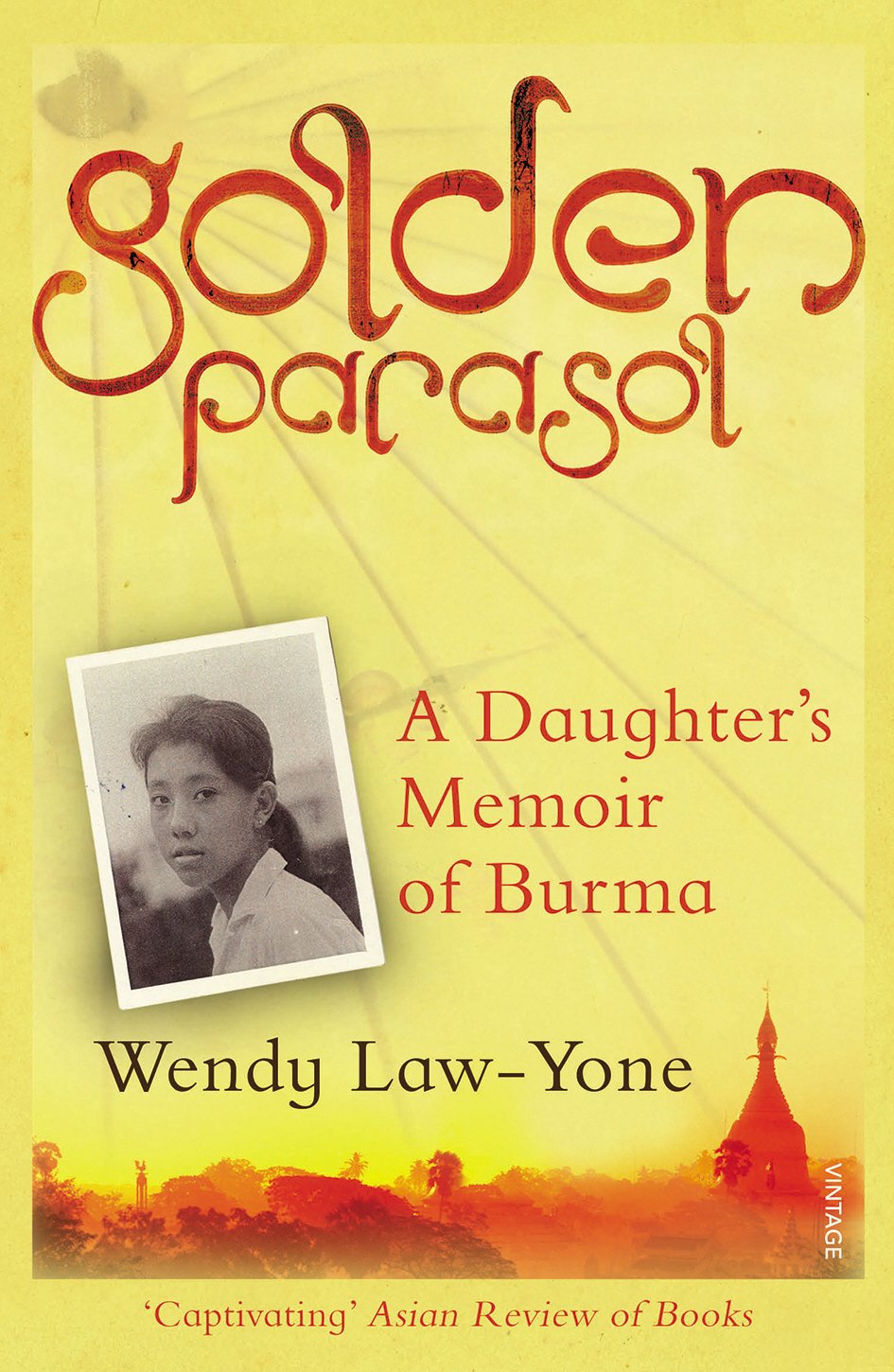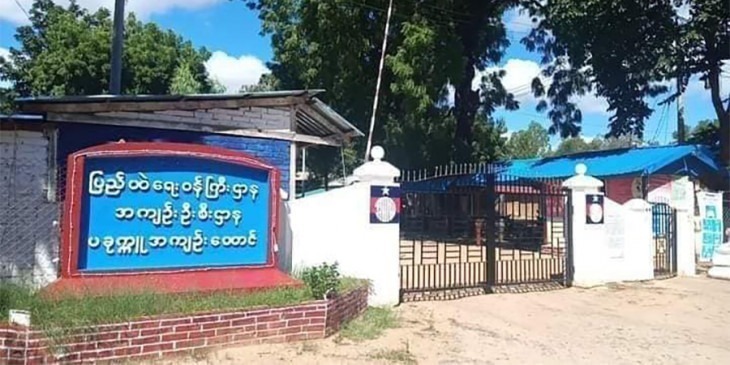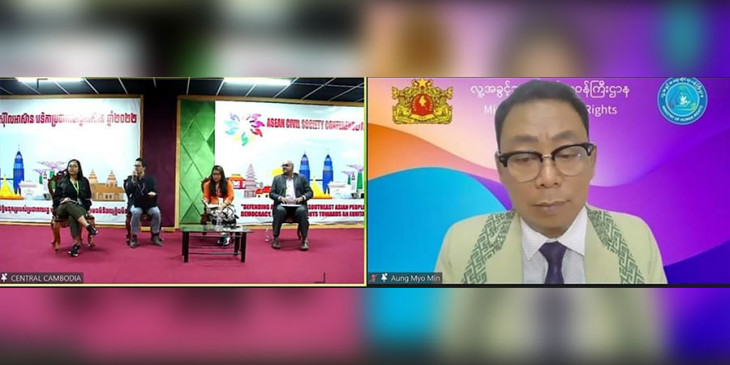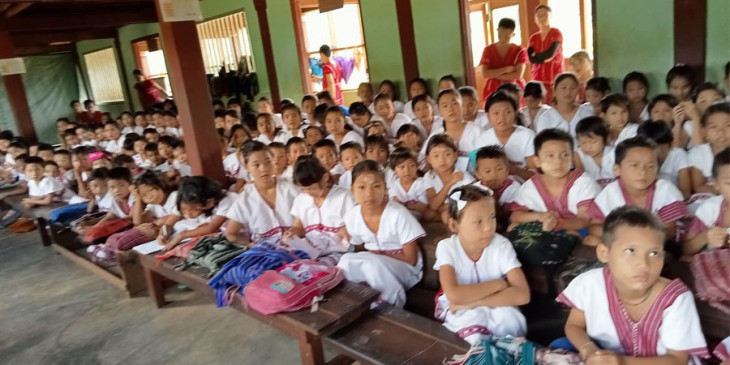DVB Reads: Episode 16 (Wendy Law-Yone on “Golden Parasol: A Daughter’s Memoir of Burma”)
Political prisoners claim torture taking place in Magway prisons
Seven political prisoners in Magway’s Pakokku Prison were tortured in late October, Monywa Strike Committee told DVB. The political prisoners are alleging they were beaten, electrocuted, and locked up for two days without being allowed to eat or sleep.
“The seven political prisoners were locked up for two entire days and were not allowed to sleep at all. They were punched, kicked, and electrocuted. So far, three of them are still locked up,” said Khant Wai Phyo, a member of the committee.
Activists speculate that the alleged torture followed a riot inside the prison on Oct. 15. It is reported that the prison authorities are planning to separate political prisoners by sending them to other prisons. According to estimates from a local politician, there are more than 5,000 political prisoners who have been detained since the 2021 coup in Magway’s two main prisons: Pakokku and Daung Nay.
“Human and prisoner rights violations are happening in almost every prison across the country. There might be orders to do this from the top-level because these acts are intentional and systematic,” added Khant Wai Phyo. The delivery of parcels to inmates has been suspended in Pakokku Prison, and goods in the prison’s shops – which are purchased by inmates – are now being sold at exorbitant prices.
The Assistance Association for Political Prisoners (AAPP) confirmed that prison staff, Burma Army intelligence officials (colloquially known as Sa Ya Pa), and the police have directly administered prisons since the coup. It has been reported that prison rules have been tightened and inmates are closely monitored in order to prevent news of violence against political prisoners from leaking to the outside world. Since the coup, a total of 12,879 people have been detained and 1,631 of them have been convicted by the junta courts, according to AAPP data as of Nov. 4, 2022.
NUG minister calls to reject junta’s election, Regime claims 1,000 students enrolled in med school
FROM THE DVB NEWSROOM
NUG minister calls on public to reject junta’s elections
The National Unity Government Minister of Human Rights, U Aung Myo Min, stated that the junta’s planned 2023 election was illegal and called on all people to reject it. He made these comments at the 2nd plenary meeting of the ASEAN Civil Society Conference/ ASEAN Peoples Forum 2022 on Nov. 4.
Regime claims over 1,000 students enrolled in medical and dental schools
The junta’s Ministry of Health Department claimed that over 1,300 medical and dental school students have enrolled and will begin the first semester on Nov. 21. The Department of Human Resources for Health announced that students will attend Yangon’s University of Medicine, Mandalay’s University of Medicine, Magway’s University of Medicine, and Taunggyi’s University of Medicine.
Fortune teller released from prison
Hein Min Aung (aka fortune teller Lin Nyo Taryar) was released from Insein Prison on Nov. 4. “I am happy to be released from prison. I am also in good health,” he told RFA Burmese. He was arrested in February 2021 and convicted of violating Section 505 (A) of the Penal Code.
News by Region
MON—The number of drug users and dealers in Ye Township has increased dramatically since last year’s coup, according to social groups treating drug addiction. “I’ve been seeing teenagers using drugs in our village,” a local said. Police and the Burma Army are involved in drug trafficking and sales, locals told DVB.
KACHIN—Nine men were arrested at Robert Baptist Church IDP camp in Bhamo on Nov. 2, according to locals. Around 4,000 displaced people are staying at the camp. “They conducted a sudden midnight inspection and arrested those who are not on guest lists. There were a lot of Burma Army personnel with vehicles and trucks. I don’t know if the arrested people were detained and that makes me worry about people in the IDP camps,” a local told DVB.
KARENNI—The Karenni Nationalities Defense Force (KNDF) announced that it will open three gates on Loikaw-Mawchi Road on Mondays, Tuesdays and Wednesdays from 6 a.m. to 5 p.m. for 14 foot canter and 12 ton dump trucks. Others will still not be allowed to use the gate. The KNDF Central Committee and Karenni State Police (KSP) made this announcement on Nov. 4.
SHAN—Four students were injured by artillery at a bible school run by the Kachin Baptist Convention (KBC) in Kutkai on Nov. 3. It damaged a male dormitory of the KBC’s Kachin Theological College (KTC). “After we heard the sound of small arms, we heard artillery fired from a military base,” a resident told DVB. The injured were sent to a hospital. According to another local, three other artillery shells were fired.
RAKHINE—People living at IDP camps in Buthidaung were ordered to leave by the Burma Army. “If we do not return home, we will be recognized as squatters. The army is deployed in our village and clashes are breaking out. The lands are not cleared of landmines. No one has lived there for four years. We are not going back there,” a resident of Yan Aung Myay IDP camp told DVB. The Burma Army has banned humanitarian aid from reaching displaced people in Maungdaw, Buthidaung, Rathedaung, Minbya, Mrauk-U and Myebon townships since Sept. 16.
Five civilians were injured during an attack by the Burma Army against the Arakan Army (AA) in Kyauktaw Township on Nov. 4. “The exact casualties from both sides are still unknown. Troops from the military bases of the No. 9 Operation Command HQ and 373rd Light Infantry Battalion fired continuously this morning,” a local told DVB. Five people in Kyauktaw Township were injured by artillery.
YANGON—A total of 21 Peoples’ Defense Force (PDF) members were arrested during a crackdown Oct. 18-24 in Dala Township, junta media announced on Nov. 3. A PDF spokesperson said: “The event is true. But it is difficult to confirm for all arrests. Now, people with good strategy will be one step ahead. So, we need to be more careful as much as possible for our safety.” On Oct. 30, junta media stated that 10 members of Inya Urban Force were arrested and charged with the assassination of ex-Brigadier General Ohm Thwin and his son-in-law.
Two alleged Pyu Saw Htee militia members were killed and three others were injured in Twante Township on Nov. 5. “The dead are brothers – Thein Zaw and Thein Win. The injured three are not in good condition as well,” a local told DVB. No group has yet claimed responsibility for the attack. Two have been killed and four have been injured in attacks so far this month in Yangon.
In Bed with Two Genocidal Regimes in the ASEAN Region: The Case of Singapore, the “Switzerland of Southeast Asia”

Running a government is not like running a church, as the 6th President, the late S. R. Nathan, angrily shouted at me some 30 years ago. But running a state should not mean collaborating and profiting from the genocidal regimes in the backyard.
by Maung Zarni for FORSEA
The year was 1993, and the venue was Van Hise Hall on the beautiful campus of the University of Wisconsin at Madison. The distinguished Singaporean was giving a distinguished public lecture at the Center for South East Asian Studies housed at Van Hise.
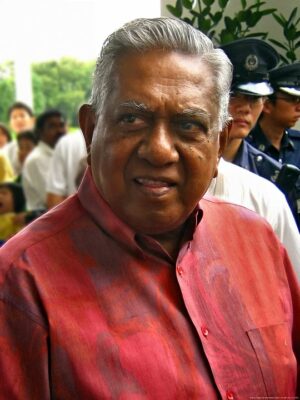
Only minutes earlier he was painting a rosy picture of Singapore as a great place for US and western investors to do business – rule of law, efficient bureaucracy, business-friendly policy climate, … and you get the drift.
When the floor was open for Q and A I stood up and pointedly asked the distinguished guest as to why his government was selling Myanmar’s State Law and Order Restoration Council, that came to power, after having slaughtered 3,000 unarmed peaceful protesters on the streets of Rangoon and other cities during the nationwide protests in August and September 1988. I had then just started my PhD studies a year before.
That was when the seasoned senior civil servant lost his cool, and went into a tirade against ethics, empathy and morality with his “government-is-NOT-a-church” answer to my question. Scholars of Southeast Asian Studies, young and old, are not naïve to expect the priestly behavior from state officials and politicians. For the region – created up the United States military command in Asia as a strategic entity during the Second World War – was littered with authoritarian regimes. And many of us lived under or exiled from these places.
But in the age of “corporate social responsibility” – which was becoming fashionable amongst US corporations and western investors, in the 1990’s, thanks to the anti-apartheid divestment movement which had swept across western university campuses and city councils – there was a widespread expectation on American university campuses: that even corporations with their foundational bottom-line logic of profit-above-the-humans – and by extension, political states were expected to draw the moral line as to who they must not do business with – international pariah regimes, murderous, genocidal or officially racist.
So, the Singaporean’s morally repugnant response to a young Burmese graduate student’s morally-loaded question won him no friends amongst Wisconsin’s liberal audience.
Fast-forward to June 2008.
I was giving a talk about the same Myanmar military leadership which blocked even the Emergency Humanitarian Aid to 2 million Myanmar victims of Cyclone Nargis which struck the Burmese coastal and delta region just weeks before my visiting lecture at Singapore’s Institute of South East Asian Studies, an arm of the Foreign Ministry.
My talk was presided over by K. Kesavapany, one of S. R. Nathan’s former subordinates in the Foreign Ministry who was Ambassador-at-large on foreign trade. In attendance was a retired Swiss Ambassador who was on a visiting fellowship. After hearing my talk on the intransigence of Myanmar military leadership, the Swiss gentleman was calling attention to the fact that Singapore was a close business partner of aid-blocking Myanmar military, and openly advocated the need for the city-state to leverage its ties to help ease the humanitarian crisis.
Reminiscent of my exchange with his old boss, then Ambassador to the United States S. R. Nathan, the seminar’s Singaporean chair went ballistic at the Swiss visiting fellow calling attention to Singapore’s economic leverage with Myanmar generals.
“You of all the people have no right to speak of (Singapore’s) collaboration with Myanmar,” shot back Ambassador Kesavapany, while accusing me of “making a meal” out of his former boss and the then Singapore President Nathan.
It was a fascinating exchange between the two retired diplomats from Singapore and Switzerland.
The Swiss banks (and the Swiss government) live with a lasting blackened image as Nazi-collaborators which gleefully did business with the SS, Hitler’s executioners, who deposited the gold from the victims’ gold teeth and other gold jewelleries melted in the crematorium-gas-chamber complexes of Auschwitz and other death camps.
See Nazi gold: Pressure builds on Swiss at http://news.bbc.co.uk/1/hi/uk/157248.stm
Particularly poignant about this Swiss-Singaporean exchange I witnessed in a small seminar room at the ISEAS is the ugly parallel between the Swiss and Singaporean model of making profit – which is anything goes, as long as a dime could be squeezed from any situation, genocides or civil wars, illicit trade of drugs or arms.
On Friday 28 October FORSEA hosted a dialogue https://www.youtube.com/watch?v=O8JpxtrA6cY&t=18s with the Singaporean scholar and human rights advocate Dr James Gomez (PhD), who directs Asia Center, to specifically discuss Singapore’s role as the shelter for Myanmar cronies, arms dealers and crooks. Our conversation was precipitated by Bloomberg News’ investigative report https://www.japantimes.co.jp/news/2022/10/18/asia-pacific/myanmar-tycoons-singapore/ on the earliest known Burmese crony Mr Teza and how Singapore has provided him and his family with a safe haven in Singapore to arrange different arms deals with Russia, Israel and other unsavoury regimes notorious for selling weapons, openly and below-the-radar.
Singapore’s collaboration with Myanmar’s genocidal regime is decades-old, and encompasses not simply economic and financial, but the area of public relations.
Ex-General Khin Nyunt, the protégé of the late Dictator (General) Ne Win, and head of the Directorate of Defence Services Intelligence in Myanmar, openly told Uzbekistan filmmaker Shahida Tulaganova, in her Al Jazeera documentary about Myanmar genocide of Rohingya, entitled “EXILED” (first, broadcast in 2018).
In Khin Nyunt’s Burmese words (and my translation): “Oh, Lee Kwan Yew-gyi was so helpful in giving us specific advice as to how to make ourselves more presentable” to the international community.

Khin Nyunt was one of the operational masterminds of the Rohingya genocidal purges which began, as an act of policy, in earnest in February 1978, just as Khmer Rouge genocide was in his final phase. Singapore’s close commercial and diplomatic collaboration with mass-murderous regimes is not a recent phenomenon, which emerged only in the 1990’s after Myanmar military hit international headlines in the late 1980’s with its blood-bath of civilian protesters calling for the end to dictatorship.
On the contrary, Singapore genocide complicity dates all the way back to Cambodian Genocide (1975-78).
In their book Getting Away With Genocide: Cambodia’s Long Struggle Against the Khmer (Pluto Press, 2004), the authors Dr Helen Jarvis and Tom Fawthrop specifically stated the role of ASEAN – the original five members of Indonesia, Thailand, Malaysia, Singapore and Brunei – in providing political and diplomatic support for Pol Pot’s regime, even after the facts of the latter’s genocide came to light in the 1980’s.
According to these two researchers, US, UK and China seated Pol Pot regime as the real representative of Cambodian people at the United Nations General Assembly until the early 1990’s. On its part, Singapore was leading the original ASEAN in providing the regional diplomatic support – and public relations campaigns – for Pol Pot.
In response to Dr Gomez’s dialogue with me, Youk Chhang, the Executive Director of the (Genocide) Documentation Center of Cambodia and a Khmer Rouge survivor, emailed me, “Singaporeans were here during Khmer Rouge genocide”. Importantly, he emailed me the DC-Cam’s “Singapore dossier”.
It is worth quoting at length from the Singapore Dossier:
“According to commerce records held by the Documentation Center of Cambodia, between 1977 and 1978, there were at least two ships that transported engine oil, automotive spare parts and other goods from Singapore to Kampong Som port on two separate occasions. The total amount of good exchanged in these instances were more than 3,750 tons or around 1, 6 million U.S. dollars.
In 2003, Youk Chhang, Director of the Documentation Center of Cambodia interviewed Van Rith, the former Chief of State for the Commerce Committee of Democratic Kampuchea. During this interview, Rith stated that Democratic Kampuchea had brought a thousand barrels of engine oil from Singapore and stored these in a state warehouse in Phnom Penh. Rith also stated that the Khmer Rouge borrowed 140 Million Yuans or $20 Million U.S. Dollars from China and the Khmer Rouge kept the money in a Chinese bank. At that time the Khmer Rouge paid the Singapore government by way of a Chinese bank.
Hem Lysieng who was a messenger of Launh, the Chief of State for Fishing at Kampong Som, told DC-Cam that Khmer Rouge had sold hundreds of tons of sea produce (e.g., fish, crab, squid, and shrimp) to Singapore through the Kampong Som port. Lysieng added that when the Khmer Rouge returned from fishing, they contacted Singapore, which promptly received the produce at the port. The Khmer Rouge also sent good quality fish, crab, squid, and shrimp to the Khmer Rouge senior leaders at office 870 every week.
After the Khmer Rouge regime collapsed in 1979, Singapore still continued diplomatic ties with the Khmer Rouge. Singapore also supported the Khmer Rouge in their effort to establish a functioning organization and continue their struggle against the People’s Republic of Kampuchea and Vietnamese forces up until the Paris Peace Accord of October 23, 1991.”
If Singapore under the late Lee Kwan Yew was in bed with the genocidal Khmer Rouge – and held Myanmar generals’ hand – for several decades, Singapore under his son PM Lee Hsien Loong is simply repeating the same genocide indifferent behaviour, while downplaying Singapore’s economic interests in the civil-war-torn Myanmar.
Two months after the bloody coup in Myanmar, Singaporean leader had this to say to the BBC Interviewer who asked, “Do economic considerations come before these humanitarian concerns?”
PM Lee: I do not think it is a matter of economic considerations or to benefit from trade from Myanmar. The volume of trade is very small for us and for many other countries. Question is, what can make a difference to them, and if you do impose sanctions, who will hurt? It will not be the military, or the Generals who will hurt. It will be the Myanmar population who will hurt. It will deprive them of food, medicine, essentials, and opportunities for education. How does that make things better?
According to the Reuters news report published two months after the 2021 coup, “Singapore had a cumulative $24.1 billion of investments approved as of 2020 since 1988.”
According to Dr Gomez’s Asia Center, many international businesses use the city-state as a conduit to bypass western sanctions and other restrictions regarding doing business in Myanmar. Of the US $442.2 million which Myanmar (military) received as Foreign Direct Investment (FDI) after the military coup of February 2021, Singapore is the Number One source at US$297 million.
While morally reprehensible, it is at least understandable that the economically struggling Singapore of Lee Kwan Yew and S. R. Nathan (aka) Ramanathan, in its 1st decade, felt compelled to make profit out of its export of US$20 million-worth of engine oil (US$120 million at today’s value) to Khmer Rouge in 1977. Here it is instructive to quote from the dossier on Singapore-Khmer Rouge relations compiled by the (Genocide) Documentation Center of Cambodia: Hem Lysieng who was a messenger of Launh, the Chief of State for Fishing at Kampong Som, told DC-Cam that Khmer Rouge had sold hundreds of tons of sea produce (e.g., fish, crab, squid, and shrimp) to Singapore through the Kampong Som port. Lysieng added that when the Khmer Rouge returned from fishing, they contacted Singapore, which promptly received the produce at the port.
But as measured in state’s conduct regarding the Asian genocidal regimes in its neighbourhood, Singapore has made absolutely no moral or ethical advancement from the founding decade of 1970’s with its per capita GDP of $1,000.00 to the 21st century where it could boast per capita GDP of $54,000.00 in the early decades of the 21st century.
Besides its existential state ideology of Survival, the Cold War in the late 1970’s freed Singapore of any external ethical or moral principles in its extraction of profits out of Khmer Rouge’s Democratic Republic of Kampuchea. The fact that Khmer Rouge’s Kampuchea was not a member of the Association of South East Asian also helped: Pol Pot’s genocide was never not on the ASEAN’s agenda.
The rich Singapore now proudly considers itself as “First World”, a cut-above-the-rest of Southeast Asia. Yet, it retains its old state conduct of doing business with un-savory regimes whatever their atrocity crimes or ASEAN membership status.
As a matter of fact, Singapore has further expanded its economic interface with the newly emerging genocidal regime of Myanmar.
By the year 2012 when the late founder (for instance, Total Oil Corporation of France and Wall Street’s JP Morgan and Chase) who wanted to diversify their otherwise lily white boards of directors and international councils, Singapore was using Myanmar not only as an important business partner — $24 billion in investment in resource-rich Myanmar is no small amount, by any standards – but also as a testing ground for the weapons developed in Singapore for global export
(See “Singapore gains toehold in world arms industry”, https://ph.news.yahoo.com/singapore-gains-toehold-world-arms-industry-203019763.html
In 2010 Myanmar military hit headlines news with the Democratic Voice of Myanmar’s ground-breaking report on its attempt to develop a nuclear weapons program.
( See https://www.npr.org/templates/story/story.php?storyId=127862297)
I travelled to Jakarta and Bangkok with Robert Kelly, a leading American weapons engineer with the International Atomic Energy Agency (IAEA) and former head of the United Nations WMD inspection team in Saddam’s Iraq to speak on Myanmar military leadership.
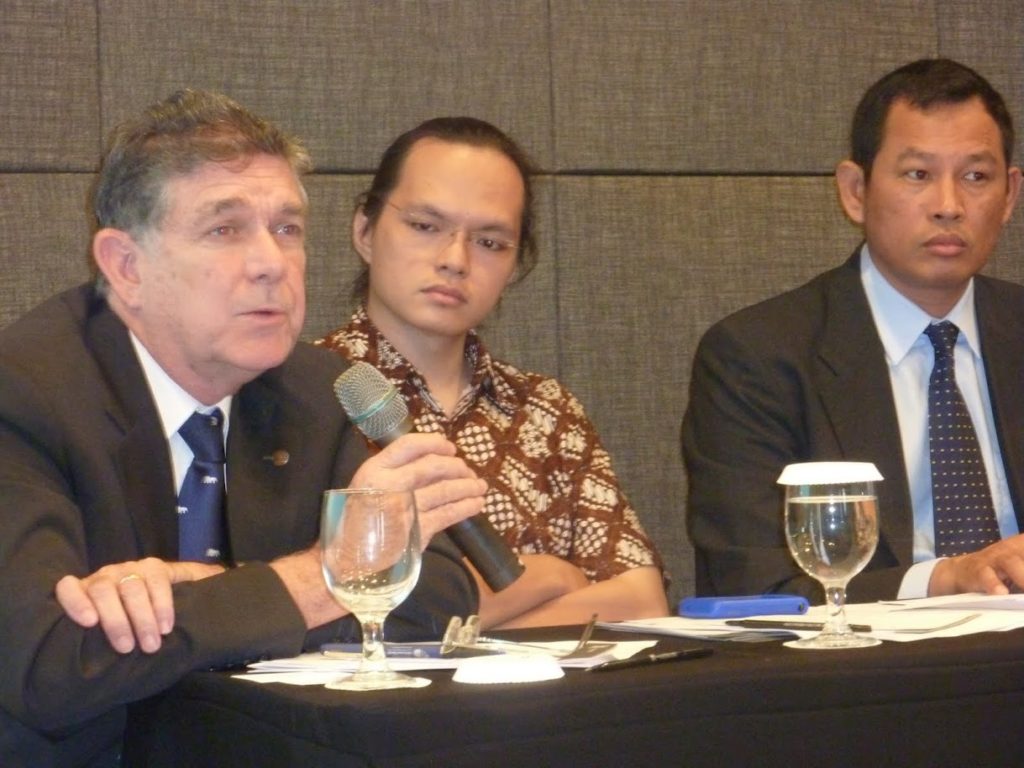
In those days, as a Burmese scholar who specializes inter alia Myanmar military’s inner workings, I was tracking down “high value” Burmese military defectors who received advanced training in Russian Federation for in-depth interviews and debriefings. My interviewees including one personal staff officer (or aide-de-camp) with the rank of a major to the head of the Procurement Division in the Myanmar Ministry of Defence revealed that Singapore had an arrangement with Myanmar regime whereby it would ship its newly developed weapons to Myanmar for testing, would shoot promotional videos for international arms markets and gift the newly tested weapons to the host – Myanmar Ministry of Defence.
In the infographic published by the United Nations Independent International Fact-Finding Mission on Myanmar or UNFFM (dated August 2019, which officially blew the genocide whistle, named Singapore alongside Russian Federation, Israel, China, India, N. Korea (DPRK), Ukraine and Philippines as a major source of weapons for Myanmar military. By then Myanmar military was credibly accused of committing a textbook genocide against Rohingyas in Western Myanmar by credible international human rights watchdogs and academic institutions (including FFM itself).
In August 2022, Justice for Myanmar, a highly regarded activist research network specializing in the economic and financial aspects of Myanmar military issued a well-researched report where a staggering number of Singapore-based subsidiary or associated companies – 38 out of a total of 78 companies – which brokered arms and equipment to the Myanmar Ministry of Defence since Myanmar’s genocide had come to light in 2017
Its report stresses that “Singapore has long been a known financial and trade hub for the Myanmar military’s arms procurement and this poses an imminent threat to the lives of millions of Myanmar people.” (see https://www.justiceformyanmar.org/stories/exposed-companies-brokering-arms-equipment-to-myanmar-military )
Indeed Myanmar military has been using its weapons to destroy religious and ethnic minorities, as well as pro-human rights activists throughout the country.
In response to the latest war crime by Myanmar Air Force – that is, air strikes on the civilian concert in the ethnic minority state of Kachin on 23 October 2022 [ Air strikes during Myanmar concert kills at least 80: Media, opposition | The Straits Times https://www.straitstimes.com/asia/se-asia/air-strikes-during-myanmar-concert-kills-at-least-80-media-opposition#:~:text=Oct%2025%2C%202022%2C%2012%3A33%20AM%20SGT%20KACHIN%20-,condemned%20by%20the%20United%20Nations%20and%20Western%20embassies. ]
Minister for Foreign Affairs Dr Vivian Balakrishnan issued the following spin:
“The Foreign Ministers discussed the situation in Myanmar and expressed deep regret over the loss of lives from the recent airstrikes in Kachin State. Minister Balakrishnan reiterated Singapore’s deep disappointment at the lack of progress in the implementation of the Five-Point Consensus, the escalation of violence and the worsening situation on the ground.”
When it comes to shedding its official crocodile’s tears, Singapore Government appears to simply cut and paste from its previous media statements. Reuters news report – dated 31 March 2021 – did not fail to notice this rather despicable act: “the framing of Singapore’s initial response to the coup was word for word the same as for Thailand’s in 2014: “Singapore expresses grave concern… we hope that the situation will return to normal as soon as possible.”
I put it to my FORSEA Dialogue guest, the Singaporean-born scholar and rights advocate Dr James Gomez, “why do you think of Singapore making noises about Myanmar’s violence and rights violations while continuing to keep their massive investment – by any standards – in Myanmar?”
His succinct reply: “Singapore is fork-tongued, (as you know).”
Obviously, Singaporean leaders – from the late LKY to his successor-son Lee Hsien Loong – and Singaporeans in general – are rightly proud of their metamorphosis from “The Third World to First.”
As one steps out of the terminals at London’s Heathrow International Airport, one notices that Singaporean passport enjoys the no-UK-visa-required status alongside Canada, Switzerland, Norway, EU, Australia and Japan. That’s no small feat for a tiny city-state with little or no natural or adequate human resources. Roughly 200,000 skilled and semi-skilled migrant workers from Myanmar alone live and work in Singapore, alongside other Asians from Indonesia, the Philippines, China, Indian, etc., as well as Israeli weapons engineers, European and N. American academics and businessmen and -women.
But Singapore’s riches and its founder Lee Kwan Yew’s coveted “First World” status have been built inter alia on the millions of corpses of fellow Asians, who have perished in the hands of Khmer Rouge and Myanmar military regimes over the last 50-years.
A few years ago, I led a small delegation of international lawyers and noted genocide scholars, including Gregory Stanton, founding president of Genocide Watch and a pioneering researcher on the Khmer Rouge genocide, to Kuala Lumpur where we met with the Malaysian Foreign Minister Saifuddin Abdullah and discussed practical ways in which the Malaysian Government could help advance international accountability on the crimes perpetrated by one of ASEAN members, specifically the genocide of Rohingyas. At a private dinner which the Foreign Minister hosted for us in Putrajaya, Malaysia’s administrative capital, I asked him why Malaysian government was open to helping activists and lawyers to seek justice for the genocide victims in Myanmar.
He answered, “we failed in Cambodia. We don’t want to repeat the past.”
Alas, no such enlightened words of acknowledgement or forward-looking policy wisdom from his Singaporean counterparts.
Singapore certainly possesses “First World” Wealth, but it tragically lacks “First World” ethics.
To belabour the obvious, running a government is not like running a church, as the 6th President the late S.R. Nathan, angrily shouted at me some 30 years ago. But running a state should not mean collaborating and profiting from the genocidal regimes in the backyard.
—
Maung Zarni is the co-author of Essays on Myanmar’s Genocide of Rohingyas (2012-18). He is a UK-based Burmese exile with over 30-years of first-hand involvement and scholarship in Burma affairs.
DVB publishes a diversity of opinions that does not reflect DVB editorial policy. We’d like to hear what you think about this or any of our stories: [email protected]
Stories, Narratives and the Battle for Our Future
Ramblings on the stories we tell about food and climate action and Myanmar
By Thin Lei Win for Thin Ink
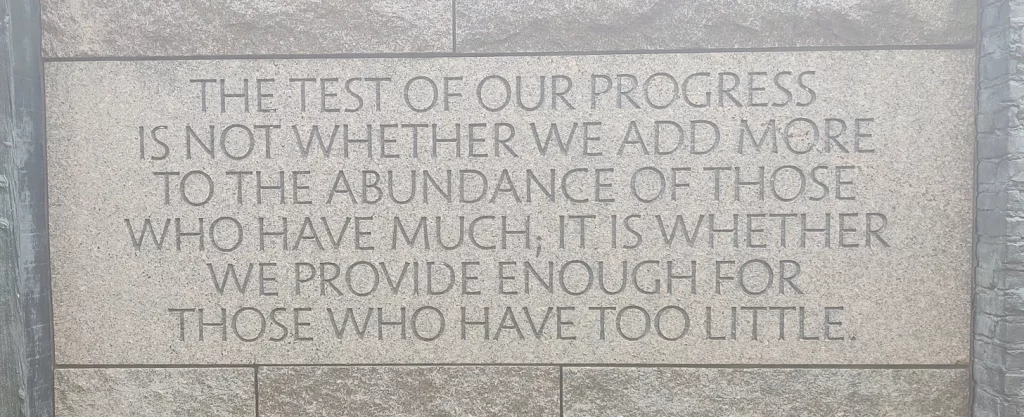
This week, you’re getting some musings from me instead of the usual analysis of reports/research findings or a Q&A with cool folks doing cool things. It was sparked by a number of things: recent discussions I’ve had on food, hunger, climate change and peace; the upcoming climate and biodiversity negotiations; and news reports that “permacrisis” is Collins Dictionary’s word of the year.
Pretty much everyone that I know is working at 150% capacity, and unlike in the past, I don’t see the end of the tunnel.
Objectively speaking, I know we live in a much better world than our forefathers in terms of economic and social development, but it’s still hard not to feel like everything is falling apart, particularly because so much of the suffering we are experiencing – whether caused by war, natural disasters or the higher cost of everything – seems unnecessary and self-inflicted.
Perhaps this melancholy is brought about by the sheer volume of news, reports and studies that confront us these days about our collective failure to rein in climate change. I realise I am contributing to this feeling with this week’s and last week’s issues. 😬
As a journalist, I understand why this deluge happens – it’s a way to keep climate change on the top of the news agenda. This means fighting off the latest celebrity divorce, the geopolitics between the world’s superpowers, a war in Europe and anything else happening domestically and internationally that might warrant column inches or airtime.
In this scenario, it’s almost impossible for news from the developing world to get any attention from the media in Europe and the U.S., where institutional donors and powerful leaders often reside. This is a constant source of frustration for aid workers, who have to find newer and more interesting ways to capture them.
Storytelling for who?
That’s how “storytelling” became a buzzword for nearly everything, from how to run and market a business, to teaching students how to make sense of the world. Can it also help to make the world a fairer place by shining a light on issues, countries and people that are normally neglected? Humanitarians think – and hope – so.
Two weeks ago, I discussed the potential of storytelling with veteran aid workers at the Human Rights Film Festival in Berlin. We were lamenting the significant gap between humanitarian needs, global attention and donor funding, and how many crises are now forgotten.
I was the moderator, not a speaker, but on a personal level, I have a stake in this conversation. You see, despite the daily brutality at the hands of a power-hungry military, the sheer incompetence of the regional bloc ASEAN and the blatant support from some of the world’s most autocratic regimes, Myanmar – my home country – has fallen off the headlines.
We feel abandoned. We feel unseen. We feel like the friend everyone forgets about. I’m sure people in Yemen, the DRC, Malawi, Venezuela, etc., feel the same. This is why, at The Kite Tales – the non-profit storytelling project on Myanmar that I co-founded with my good friend Kelly – we’ve pivoted away from featuring first-person accounts of ordinary people’s lives.
Our focus now is on publishing anonymous diaries from a handful of journalists across the country on how they and their communities are surviving under the military rule, along with providing financial support to the journalists and illustrators.
This was a conscious decision. We want – and need – more attention on Myanmar, especially from countries that could make a difference, and we want to support Myanmar journalists and illustrators, many of whom have lost their jobs and are struggling to survive or are on the run.
But a question from the audience (around 1:34:00 in that YouTube video) gave me pause. In essence, he asked who we are centring in these stories – ourselves (as the arbiters of whose stories we tell), the readers (who might they be?), or the people who have been forgotten and whose stories we’re using to achieve our aims?
That was a question neither I nor the speakers could answer properly in the short window we had. I told him what we were doing and why, but the question stayed with me and made me wonder whether, for all the talk about decolonising aid and humanitarian action, we are perpetuating the inequality.
Duelling narratives
I think many of us in the humanitarian/food/climate space are fixated on forgotten crises for a few reasons.
For one, we know that the suffering of these communities will worsen with climate change, a problem that they didn’t cause. For another, getting others to empathise with their plight could result in more aid, as well as quicker climate action. It’s also a way to redress the imbalance of whose stories get covered.
Here, we face another challenge because just as much as we think turning these issues into stories people can relate to, with protagonists and antagonists and all the plot twists that come with riveting tales, the other side – I’m trying not to write “the dark side” – thinks so too.
In fact, Big Tobacco and Big Oil have made this an art form, successfully blurring the lines by questioning the links between smoking and cancer, and fossil fuels and climate change.
Their methods include questioning the science, questioning the cause of harm, offering silver bullets, pushing false narratives, and co-opting the right lingo to engage in greenwashing. There are countless examples of this but these instances in the past two weeks alone are enough to cause anyone who cares about the environment to lose the plot.
- The new, much-talked-about news outlet Semafor launched its climate newsletter, proudly sponsored by fossil fuel giant Chevron. Read more here.
- The Washington Post reports that Hill+Knowlton Strategies – a PR firm that has represented Big Oil and been accused of developing the “tobacco playbook”– is managing communications for Egypt, this year’s host of the UN climate summit.
- New York Times columnist Bret Stephens – who used to dismiss climate concerns – had a change of heart after visiting Greenland but has proposed “natural gas” as the solution, to the loud groans of journalists and experts who have been working on this issue for decades. Heated wrote about how Stephen’s stance is essentially an echo of the oil and gas industry, and here’s a piece from environmental legal charity ClientEarth on the greenwashing claim that natural gas is clean.
To me, the climate debate provides a useful roadmap and lessons for those in the food systems movement, because I reckon that the latter is a couple of decades behind the climate movement.
Broadly speaking, there are two main camps on transforming food systems, those who believe we need to boost production (usually large-scale) to feed a growing population and to do so sustainably would need the latest technologies such as GMOs, gene editing, alternative proteins, etc., and those who think the answer lies in supporting small-scale, agroecological farming and dismantling the unequal power structures prevalent in modern food systems.
How big is the gap between the two? Pretty big. At an event I recently attended, a diplomat from a rich nation said something along the lines of, “Philosophy doesn’t feed people. Food does.” It felt like a thinly veiled lecture at those who are advocating for food sovereignty and justice.
Obviously, I disagree with this stance. I think philosophy is crucial because it will determine what kind of food we produce, how we do it, and whether the younger generations have a viable future.
But Big Ag is following the playbook used by Big Oil and Big Tobacco. They’re co-opting the lingo, they’re questioning the science and they’re producing reports calling for farming to change.
I believe that these duelling narratives are going to escalate in the coming days and weeks. Why? For starters, not only is this year the first time that food and agriculture will have an official pavilion at the COP, but there will be at least three of them!
- The official Food and Agriculture Pavilion with the UN FAO, Rockefeller Foundation and the CGIAR non-profit research centres
- Food Systems Pavilion
- Food4Climate Pavilion
There’s also the UN Climate Change ‘Global Innovation Hub’ (UGIH) Pavilion, which has elements of food.
Oliver Camp, currently a senior associate at Global Alliance for Improved Nutrition (GAIN), has very helpfully provided a timetable of all the food-related events at the COP here.
I’m glad that food and agriculture are taking their rightful place at COP after many years in the wilderness.
Besides, there are many, many good folks who are in these pavilions whose opinions I really respect. But – there’s always a but, isn’t there? – the same corporate and political powers that have little interest in systemic change will also be there. For more on this, check out these stories from DeSmog.
Another reason that the debate is about to get even more heated? Next year’s COP will be hosted by the United Arab Emirates, which co-leads the AIM for Climate (Aim4C) initiative with the U.S. and has been an outspoken champion of new technologies and innovation to improve agricultural production.
Activists and farmer groups have criticised AIM4C as focusing only on technofixes, but supporters are proud of the breadth and depth of partners it has accumulated since launching at last year’s COP.
What’s clear is that there will be efforts to build on this year’s momentum and narratives around food systems transformation. This means both sides will have to push their visions so that they become the prevalent narrative around how to make our food systems fairer, better, cleaner and greener.
Me? I’m sceptical about the call to produce more food at any cost, but I’m also not against – horror of horrors – GMOs or gene editing per se, as long as these are not in the hands of a few corporate behemoths who wield intellectual property rights to criminalise traditional seed systems, and health, safety and environmental concerns are taken into account.
The battle for our future
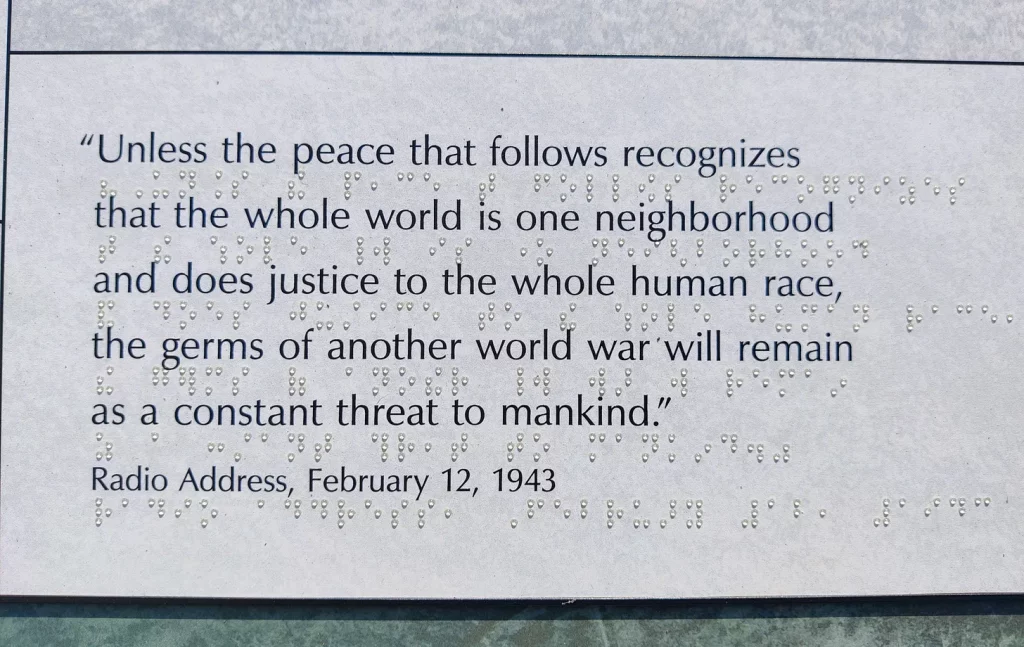
There are competing narratives in Myanmar too. The military junta that overthrew the civilian government last year is saying they will hold elections next year, after which all will be peachy.
I can honestly say I don’t know any Burmese people who buy into this (unprintable word), but some governments have taken these pronouncements at face value so they can help legitimise this regime.
Just recently, Singapore’s foreign affairs minister described the situation as “a fight for the heart of the Bamar majority, between the Tatmadaw on one hand and the National League for Democracy led by Daw Aung San Suu Kyi, who won the election in 2020”.
This is an incredibly bad take and completely discounts so many facts, including that the battle, both literally and figuratively, is not just between these two political elites, but between a ruthless, autocratic institution and pretty much everyone else in Myanmar.
You may think I’m crazy but I’m seeing a lot of parallels between what the Myanmar junta is doing to derail a country and what Big Oil and Big Ag are doing to derail our planet.
You may also say it’s unfair to compare the murderous and intransigent Myanmar junta, so horrible it would not pass muster in a Bond film script because of how one dimensional it all is, with the powerful forces in food systems and climate change.
But are they really that different?
In very simple terms, both are anti-democratic, crave money and power above and beyond what they already have, and put their sole survival above all else.
If all this sounds daunting and dispiriting, well, it is. But I remain hopeful AND optimistic that we will get there – a thriving, democratic Myanmar and fairer, better, cleaner and greener food systems. Because to give up, to lose hope, is to let the bad guys win, and we can’t let that happen.
As always, have a great weekend! Please feel free to share this post and send tips and thoughts on twitter @thinink, to my LinkedIn page or via e-mail [email protected].
Subscribe to Thin Ink
A Weekly Publication on Food, Climate and Where They Meet
Junta eliminates languages from state school curriculum
Regime media announced that the junta has altered the Myanmar National Education Law to remove ethnic nationality languages from the main school curriculum on Oct. 29. The amended law includes 21 sections. Eighteen points from the Myanmar National Education Laws of 2014 and 2015 were replaced. Two paragraphs were added, while sections and subsections were removed from the laws. Sections that allow the formation of teachers’ and students’ unions in higher education institutions were removed by the junta. The law also renamed the National Education Policy Commission into the National Education Commission. This gives the commission direct control over education without input from the president and members of parliament.
Under the previous version of the law, Burmese, English, and ethnic nationality languages, could be used as the main teaching languages in classrooms. The new version of the law stipulates that only Burmese language can now be used to communicate in classrooms at Basic Education level schools. The Development Media Group (DMG), a Rakhine State-based media outlet, reported that the Rakhine Students’ Union (RSU) opposes the junta’s revision of the law. The RSU states that the law is now discriminatory and intended to wipe out ethnic minority languages in Burma.
“The altercation to the law erases everything about mother languages which is an element of federal education. We have not accepted the military council and fought against them since the beginning. We are not recognizing laws enacted or amended by the junta,” said Min Lwin Oo, a committee member of Democracy Movement Strike Committee-Dawei. Min Lwin Oo participated in a 2015 students’ strike against the previous version of the Myanmar National Education Law. The law was enacted in September 2014 and was revised in June 2015 after the successful Democratic Education Strike Campaign led by students.


